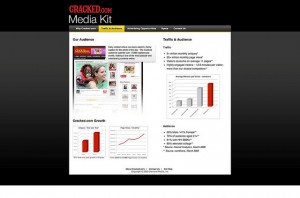14.8 Data from Media Kits

Another important source of information about audiences is the media kit produced by media outlets that are seeking ad dollars. Primarily used by advertisers who need to decide whether to place an ad in that publication, on that website or on that tablet edition, the media kit can also be a good source of information about the audience for a freelancer or journalist who needs to understand how to pitch an article or please an editor (the “gatekeeper” audience discussed in previous lessons).
For example, a major magazine publisher such as Conde Nast produces media kits for all of its titles. For Vogue magazine, there are media kits for the print, web and tablet version of the title.
The Vogue media kit shows that for the print version of the magazine, the audience data look like this:
- Median age 37.8
- Household income $58,612
- Female/Male 88% / 12%
- Any college 65%
- Employed FT/PT 65%
- Median age 39.7
- Household income $89,838
- Female/Male 64% / 36%
- Any college 82%
- Employed FT/PT 73%
- The web audience has a significantly higher income, meaning the advertisers of high-priced items might want to focus their budget on web ads rather than buying an ad page in the print edition.
- The percentage of male audience members is higher for the web version than for the print version. If you are placing ads for a gender-neutral product, you have a better chance of finding male audience members via the web version.
- A journalist might get an idea for a story that looks at whether men feel uncomfortable subscribing to or buying a title such as Vogue on the newsstand but are much more likely to view the content online based on the media kit insight about a higher percentage of male audience members for the web version of the magazine than for the print edition.
Another portion of the media kit lays out the editorial philosophy of the publication:
“The foundation of Vogue’s leadership and authority is the brand’s unique role as a cultural barometer for a global audience.
Vogue places fashion in the context of culture and the world we live in — how we dress, live and socialize; what we eat, listen to and watch; who leads and inspires us. Vogue immerses itself in fashion, always leading readers to what will happen next. Thought-provoking, relevant and always influential, Vogue defines the culture of fashion.”
If you are a freelancer hoping to pitch an idea for an article in Vogue, you need to understand how the magazine editors define their editorial focus and their audience’s interests. In this case, you would need to recognize that your pitch for a story idea must incorporate a “global” perspective and take a cultural approach to the topic in order to meet the audience’s expectations. This portion of the media kit also provides biographical information about the top editors. You would certainly want to understand as much as possible about these “gatekeeper” audience members as possible before preparing your story pitch letter and proposal.

